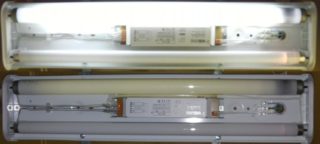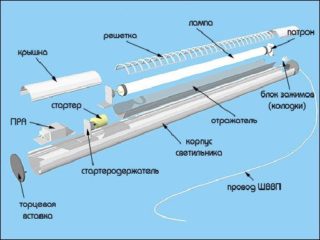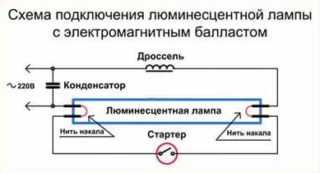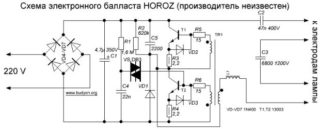Fluorescent light sources are commonly referred to as fluorescent lamps. They are characterized by low energy consumption and long service life. The emission spectrum is visually close to that of the sun. A significant disadvantage of fluorescent lamps is that they cannot be connected directly to the network. It is necessary to use special control gear (ballast). Ballast devices create the possibility of a stable gas discharge and uniformity of the luminous flux during operation.
Luminaire design

Incandescent and fluorescent lamps are connected in different ways, but any, even the highest quality, light sources can burn out. There are many reasons for the inoperability of fluorescent lamps. To identify them, you need to briefly familiarize yourself with the design and operation.
The principle of operation of fluorescent lamps is an electrical discharge that occurs in mercury vapor. The emitted ultraviolet light is converted into visible light by a special substance - a phosphor, which is applied to the inner surface of the lamp bulb.
For a gas discharge to occur, a high voltage is required, which is created when the lamp is turned on due to the use of ballasts.
There are two fundamentally different types of ballasts:
- electromagnetic, which uses a choke and a starter;
- electronic, collected on radio-electronic components.
Any discrepancy in the parameters or failure of one of the elements leads to the complete inoperability of the luminaire.
Electromagnetic ballast
The presence of mechanical contacts is the weakest point of the electromagnetic ballast. Starters fail most often, especially if the light is turned on frequently. The reason for the breakdown of the choke is the turn-to-turn circuit. In addition, the choke is a strong source of electromagnetic interference and can generate a strong hum.
Electronic ballast
Electronic ballasts are characterized by small dimensions, weight and high reliability. Unfortunately, a number of manufacturers use low-quality components in production to reduce costs, which leads to the failure of electronic ballasts.
The most common cause of failure of electronic devices is the loss of capacity of electrolytic capacitors and the breakdown of the transitions of high-voltage key transistors. Self-correction of the functionality of electronic components requires high qualifications and is not available to most consumers.
The same difficulties are associated with the manufacture of homemade devices for starting lamps, although there are many schemes, the use of which can increase the life of fluorescent lamps.
In addition to malfunctions associated with the failure of the ballast, the lack of glow can be caused by the lamp itself. Fluorescent lamps have electrodes in the design, which are coated with a special compound to facilitate starting.Over time, the composition burns out and a short-term high-voltage pulse removed from the starter and throttle is no longer able to ignite the gas discharge. In this case, the discharge is reignited. Over time, the light starts blinking and stops firing.
The burning out of the phosphor leads to a gradual decrease in the luminescence brightness. This process occurs most rapidly near the electrodes. In this case, the fluorescent lamp does not burn or its brightness is not uniform along the entire length of the lamp.
How to repair a fluorescent lamp

In most cases, the easiest solution is to replace the faulty components. You can check by installing a known good element. A full-fledged repair of a fluorescent lamp is fraught with a number of difficulties and requires certain qualifications and experience. Before disassembling the fluorescent light, you must make sure that it is disconnected from the mains and that no electricity is supplied to it.
The easiest way to find a replacement for a faulty starter. You can make the lamp turn on by installing a button instead. This method is dangerous in that holding the button over the required time can cause burnout of the filaments of the electrodes.
It is more difficult to use lamps without a choke. Several workable options for such an inclusion have been developed. Most circuits use the principle of multiplying the mains voltage for stable starting. In these circuits, rectifier diodes and capacitor banks are used, which causes an increase in the size of a homemade ballast. A powerful resistor or incandescent lamp 25-40 W is used as a choke to limit the current, depending on the power of the fluorescent lamp.
The advantage of resistors is in small dimensions, but the problem is high heat generation on it during operation. Incandescent lamps create an additional luminous flux, but since they operate at reduced voltage, their service life is practically unlimited.
Separate circuitry solutions for electronic ballasts or multiplication circuits allow the use of bulbs with burned-out filaments. However, due to the fact that a high voltage is used during start-up, and the current after ignition is slightly limited, the operating time of such fluorescent lamps is rather short.
Extending service life
- Low temperature operation will increase the heating time of the filaments before the onset of a stable gas discharge, as a result, the lighting fixture may burn out faster than the declared service life.
- Frequent switching can also cause premature aging and burnout of the electrodes, since inrush currents are much higher than steady state conditions.
- Low-quality ballasts use simplified circuitry and, apart from low cost, do not offer any advantages.
Recommendations for increasing service life:
- Do not use fluorescent lamps in low temperature rooms.
- Avoid frequent switching on. The considered light sources consume a small amount of electricity compared to incandescent lamps, so in some cases it makes sense to leave them on all the time.
- Use electronic ballasts with soft start. Such devices are somewhat more expensive and cause a turn-on delay (about 1-2 seconds), but they reduce the aging rate of the electrodes and allow for the possibility of frequent switching on.
- Purchase fluorescent lighting fixtures from reliable manufacturers. The high cost is justified by the uptime.
Highly toxic mercury is contained inside the lamp bulb. Disposal of defective lamps must comply with legal requirements.












Good article for those who want to know more about light sources.
The engineer who in the past first proposed a glow discharge starter with bimetallic contacts for the ignition of fluorescent lamps should be called to harsh responsibility as a criminal before humanity !!! Due to his invention of the starter, the fluorescent lamps one after another fail from the emitter oxide layer falling from their heated cathodes due to repeated contacting of the starter each time the lamp is turned on with temperature drops of its heating cathode spirals with cracking and crumbling, like flour, from the oxide layer from them barium oxide emitter. And because of this invention, mankind produced a lot of mercury waste, which could not have been, due to the premature failure of these lamps !!! Secondly, the heating cathodes of a fluorescent lamp, when ignited, should not overheat to such an excessive starting temperature, which in the starter circuit must be done for a longer duration of their cooling after opening the bimetallic contacts of the starter, which increases the reliability of its ignition. Thirdly, it is a blatant engineering barbarity to use the heated cathodes of a fluorescent lamp only when it is started, and during its operation they do not need to be heated at all, using them only in the mode of destructive cathode spots on field emission without heating them during lamp operation, instead of thermionic emission in the mode of their heating by a low voltage source of filament of the cathodes and balancing the operating current of the lamp supplied to them. Even when a fluorescent lamp is connected to an AC power frequency network through a conventional inductive electromagnetic ballast, a three-winding step-down filament transformer must be installed, and not some kind of starters !!! The primary winding of this incandescent transformer is connected parallel to the lamp after its ballast choke, and both its secondary windings are connected to the terminals of the corresponding heated cathode of the lamps through diode rectifier bridges as a balancing element of the supplying operating current of the lamp at both ends of the spirals of its heating cathodes. When a lamp is started in such a starterless circuit, its inclusion in the network, heating of its cathodes from an incandescent transformer comes immediately when it is turned on, and it keeps continuously with the network voltage simultaneously applied between its cathodes for as long as necessary until it lights up, so there is no need thermal inertia for the reliability of its ignition, which reduces their starting heating to a safe value. But after the lamp lights up, both the voltage on it and on the primary winding of the filament heating transformer connected in parallel with it sits down in the lamp ballast choke, and in this regard, the heating of the lamp cathodes decreases from its starting value to its operating value, but does not disappear at all, thereby ensuring the maintenance of the arc discharge in the thermionic emission lamp of the entire surface of its cathodes instead of burning cathode spots !!! And this has already allowed me to get in practice, even with frequent switching on, the duration of burning of fluorescent lamps is often longer than in some cases for LED lamps. Alexei.